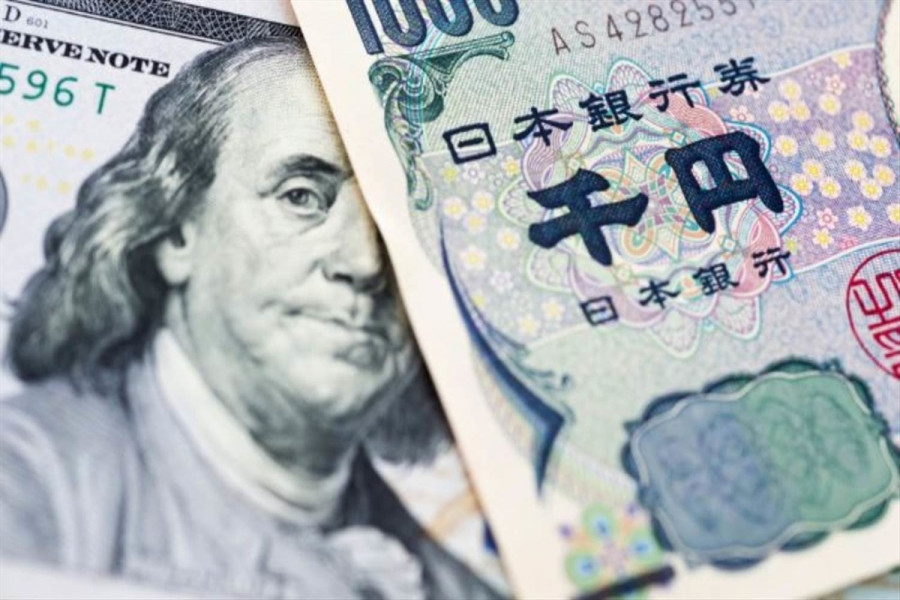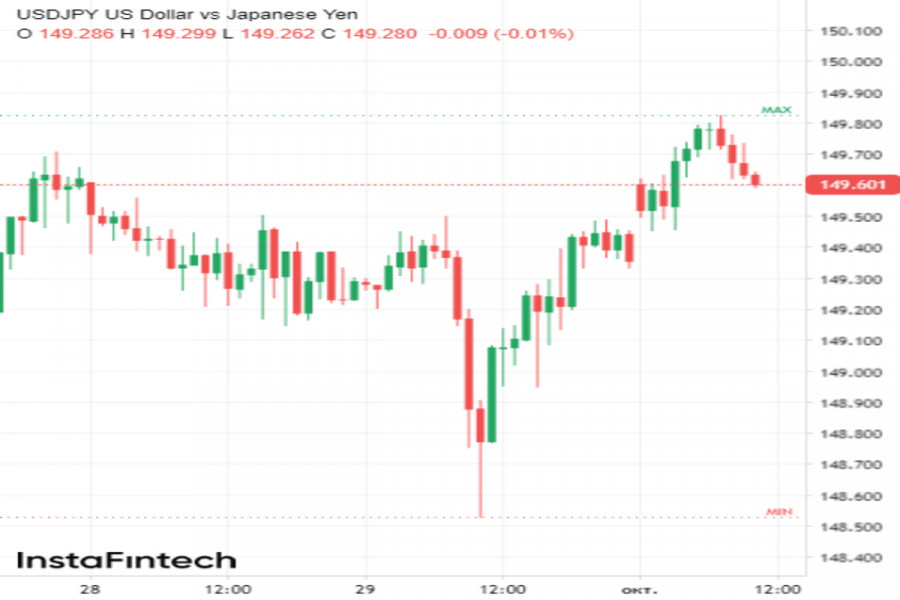Voir aussi


 02.10.2023 12:54 PM
02.10.2023 12:54 PMAt the start of the new trading week, the dollar/yen pair showed a surprising burst of strength and came close to the level of 150, the achievement of which could trigger a Japanese intervention. What caused such a situation, and what results may it have?
Why may the US dollar skyrocket?
Early on Monday, the dollar/yen pair tested a new 11-month high of 149.81 despite the high risk of currency intervention from Tokyo.
Japan's Minister Shunichi Suzuki threatened speculators again this morning, saying that the government would take necessary measures in case of further JPY depreciation.
Notably, the current weakness of the Japanese currency was spurred by a serious divergence between the monetary policies of the Fed and the BOJ. The first regulator is a supporter of a hawkish course, while the latter prefers a dovish one.
Although the US central bank paused rate hikes in September, markets are now speculating about the continuation of tightening in the US this year.
The Fed will hold its next monetary policy meeting in early November. By then, the regulator should have some important economic data to help it make a decision on interest rates.
Last week, there were fears among investors that this data might not be an issue as the threat of a shutdown—the suspension of government agencies—loomed over the US.
To avoid this, last Saturday, the US Congress passed a bill to temporarily fund the government. This news allowed USD buyers to breathe a sigh of relief and inspired them to open new long USD positions.
Analyst Chris Weston said that traders had a strong belief that the US Labor Department would release key non-farm payroll data later this week and the Consumer Price Index report on October 12. Notably, this may happen if the US government shutdown passes.
September nonfarm payrolls should be the main trigger for dollar majors this week. Economists now expect the release to point to a decline in new jobs from 187,000 to 150,000 and to signal a decline in unemployment (from 3.8% to 3.7%) and an increase in average hourly earnings (from 0.2% to 0.3%).
If real data shows that the US labor market remains resilient despite the Fed's long-standing aggressive policy, this could support demand for the greenback across the board.
Analysts believe that a stronger-than-forecast US jobs report will reinforce traders' hawkish sentiment towards the Fed's future monetary course, which will serve as another driver for USD/JPY.
It is not excluded that, on the wave of optimism about another round of rate hikes in the US, the quote may soar at the end of the week above the 150 mark, which many investors consider a potential intervention level.
Currency strategist Olivier d'Assier shared his opinion, saying that the fear of Japanese intervention appeared in the market when USD/JPY crossed the threshold of 146. The major is now trading above 149, and the Bank of Japan has yet to take any action other than verbal warnings. This may force traders to buy the major.
Why is the yen doomed to fall?
Thanks to the ongoing monetary divergence between the US and Japan, the American currency gained 3.5% against its Japanese counterpart in the third quarter after climbing 8.7% in the second quarter.
Now most analysts expect further strengthening of the dollar/yen pair. There is an opinion that in the first half of the fourth quarter, the asset may strengthen to the level of 155 if the Japanese government does not decide to conduct currency intervention, and the fundamental background will continue to favor the rise in the US dollar.
The current fundamental picture is clearly not in favor of the yen. At its last meeting, the Japanese central bank maintained its ultra-soft policy, which is characterized by negative interest rates, and promised to stick to it in the foreseeable future.
Last weekend, BOJ Governor Kazuo Ueda repeated his dovish comments. The official said the Bank of Japan had a long way to go before abandoning its ultra-soft monetary policy.
At the start of Monday's session, additional pressure on the yen came from the publication of the BOJ's September meeting summary. The document reads that at this stage, the majority of Japanese officials are opposing additional changes to the YCC mechanism and supporting dovish policy.
"They're wary of tightening too early and squashing... a rise in inflation and growth," said Jarrod Kerr, chief economist at Kiwibank. "They deserve to be cautious, though."
Meanwhile, data released last Friday showed that core inflation in the Japanese capital slowed in September for the third straight month.
Since the Tokyo CPI is released earlier than the national CPI, it always serves as a benchmark for a preliminary assessment of inflation in the country. The slowdown in this indicator may indicate a downward inflationary trend in Japan, which is a strong argument for the BOJ to follow the dovish course.
Technical Analysis
The pair remains above the 50-day and 200-day EMAs, which indicates stable bullish momentum. If the asset manages to avoid falling to the 148.40 support level in the short term, it is likely that buyers will soon be able to test the 150.29 resistance level.
On the other hand, a drop below 149 will support the major's movement to the support level of 148.405.
You have already liked this post today
*The market analysis posted here is meant to increase your awareness, but not to give instructions to make a trade.
La pause dans les tarifs douaniers entre les États-Unis et la Chine stimule le sentiment, mais des inquiétudes persistent. Les actions européennes ont augmenté pour la quatrième séance consécutive
Les actions de Citigroup enregistrent des gains réguliers après avoir dépassé des niveaux techniques clés, ce qui indique un potentiel de hausse continue. Les participants du marché considèrent l'action
Les indices grimpent : Dow 2,81 %, S&P 500 3,26 %, Nasdaq 4,35% Les actions surpassent les valeurs refuges grâce à un assouplissement commercial Apple grimpe suite à un rapport
Les indices boursiers américains progressent dans un contexte d'optimisme autour des avancées potentielles dans les négociations commerciales entre Washington et Pékin. Les investisseurs espèrent qu'un éventuel accord pourrait apaiser
Les marchés montent : les États-Unis et la Chine se rapprochent dans les négociations commerciales. UniCredit en hausse : bénéfice supérieur aux attentes, prévisions relevées. Affaiblissement des pharmaceutiques
Les principaux indices boursiers américains ont terminé la séance en hausse, soutenus par les déclarations de Donald Trump indiquant des progrès dans les négociations sur un important accord commercial
Les principaux indices boursiers américains ont clôturé en territoire négatif, le S&P 500 en baisse de 0,8% au milieu d'une incertitude croissante concernant la politique commerciale et dans l'attente
Les actions chutent en raison de l'absence d'accords tarifaires avant la décision de politique monétaire de la Fed. L'or chute dans l'espoir de négociations commerciales entre les États-Unis
Notifications
SMS/E-mail

Your IP address shows that you are currently located in the USA. If you are a resident of the United States, you are prohibited from using the services of InstaFintech Group including online trading, online transfers, deposit/withdrawal of funds, etc.
If you think you are seeing this message by mistake and your location is not the US, kindly proceed to the website. Otherwise, you must leave the website in order to comply with government restrictions.
Why does your IP address show your location as the USA?
Please confirm whether you are a US resident or not by clicking the relevant button below. If you choose the wrong option, being a US resident, you will not be able to open an account with InstaTrade anyway.
We are sorry for any inconvenience caused by this message.


